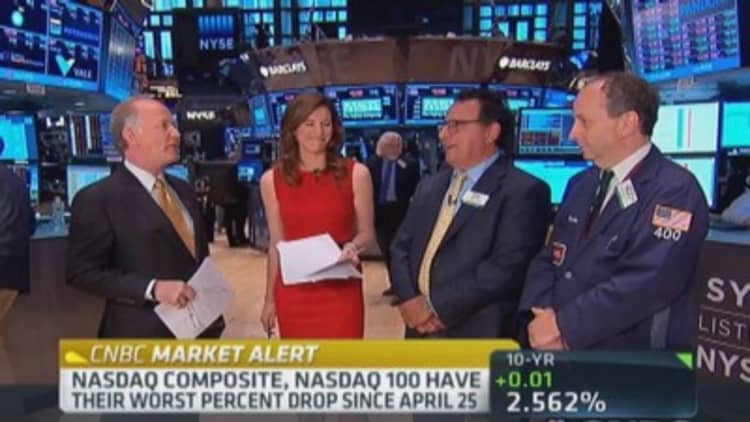Even as calls for a sharp correction on U.S. stocks grow louder, one contrarian commentator told CNBC the bull run is far from over and stocks have a further 25 percent to run.
The S&P 500 closed 2 percent lower on Thursday at 1930.67, as investors fretted over Europe's economy, an Argentine default and a jump in U.S. labor costs, which prompted concerns about corporate margins. The index had hit a record high last week of 1991.39, a near 200 percent rise on the market's mid-2009 low.
According to Peter Morici, professor of economics at the University of Maryland and former chief economist at the U.S. International Trade Commission, digital technology will be the key driver of further gains on Wall Street in the coming years.
Read MorePaul Singer: US stocks 'frothy' by 'all measures'
"The bull market is not done," he said. "Digital technologies permit businesses to use investors' cash far more efficiently these days, and could easily push up stock prices another 25 percent," he added, giving a time period of three to five years.
"Obviously if we go to war in Russia all bets are off, but barring some cataclysmic event and if we just have a normal adjustment (like we saw on Thursday), I see us getting it all back and over a period of time we will have sustainable price to earnings ratios higher than the last 25 years," he said, adding that he would not rule out smaller corrections along the way.

According to Morici, because digital technology has reduced the need for corporate spending leaving companies flush with billions of cash in excess profits, the S&P 500 should climb to levels of around 2500 over the next 3-5 years.
Read MoreMarc Faber predicts 20% to 30% drop in stocks
"Old line industrial firms can use factories and manage supply chains more efficiently. Modern multinationals like GE exploit new products and markets, and generate vast profits, with much less cash than in decades past," he said. "The abundance of financial capital pushes up sustainable stock prices and price-earnings ratios."
And despite S&P 500's price to earnings ratio (P/E) looking expensive, hitting 19.60 last week, Morici notes it's still below the 25.0 level back in 1998, when the index first crossed the 1,000.
"Considering how efficiently the digital economy can create wealth from investors' cash, a P/E ratio as high as 25 and the S&P index trading at 2500 are quite possible," he added.
Morici's contrarian call stands out amid a plethora of bearish voices warning of a severe correction, describing the S&P 500 as extremely overvalued.

Paul Krake, founder of View from the Peak: Macro Strategies, told CNBC Asia's "Squawk Box" that he expected a 10 percent correction on the S&P 500 by year-end, triggered by the end of the Fed's tapering program which most expect to occur in October.
"A 10 percent correction should be perfectly acceptable given that at the end of QE1 we had an 15 percent correction on the S&P, and at the end of QE2 we had a 22 percent correction. This shouldn't surprise anyone," he said.
Read MorePutting millions where his mouth is, trader bets on S&P
Morici disagrees that an unwinding of Fed's stimulus will impact appetite for equities, arguing that although short term rates will rise, medium and long term rates will not see such a steep gains. This is because continued demand for US Treasurys from China and safe haven buyers will keep rates on the longer end of the curve low.
Other analysts CNBC spoke to said they were confident U.S. equities to be able to withstand the end of tapering.
"We have a fair index value for the S&P 500 of 2000...We don't expect a correction given that both, the end of tapering as well as rising fed fund rates are largely expected by market participants and thus should not catch them wrong-footed," said Christoph Riniker, head of strategy research at Julius Baer.


